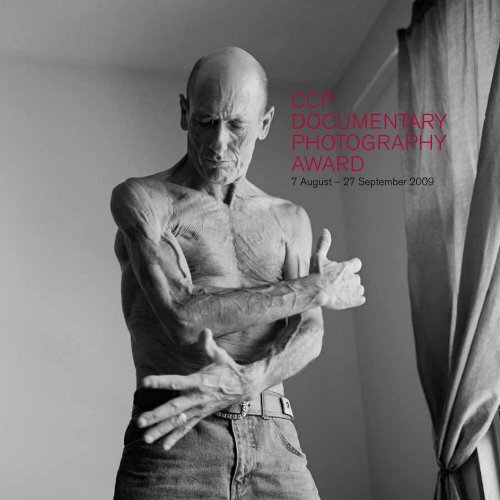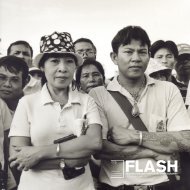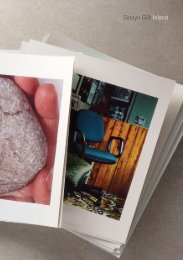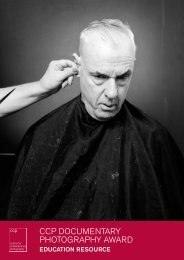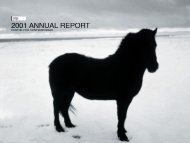ccp documentary photography award - Centre for Contemporary ...
ccp documentary photography award - Centre for Contemporary ...
ccp documentary photography award - Centre for Contemporary ...
You also want an ePaper? Increase the reach of your titles
YUMPU automatically turns print PDFs into web optimized ePapers that Google loves.
CCP<br />
DOCUMENTARY<br />
PHOTOGRAPHY<br />
AWARD<br />
7 August – 27 September 2009<br />
1
MATTHEW AbbOTT<br />
PAUl bATT<br />
JAMES bRiCkWOOD<br />
DARREN ClAYTON<br />
GEORGiA METAxAS<br />
SiMON O’DWYER<br />
ANDREW QUilTY<br />
lEAH RObERTSON<br />
DEAN SEWEll<br />
lAki SiDERiS<br />
TOM WilliAMS<br />
kRYSTlE WRiGHT
CCP<br />
DOCUMENTARY<br />
PHOTOGRAPHY<br />
AWARD<br />
7 August – 27 September 2009
4<br />
FOREWORD<br />
Cover image:<br />
Tom Williams<br />
Tony ‘Fingers’ Randall,<br />
Vietnam war veteran and<br />
security guard 2007<br />
Haunting, provocative or simply well observed, <strong>documentary</strong><br />
<strong>photography</strong> has borne witness to contemporary life since<br />
its invention in the late nineteenth century. While capture<br />
technologies have vastly improved, essential elements remain<br />
the same: a device <strong>for</strong> recording light, something observed<br />
in the world and a passionate desire to influence and<br />
communicate rather than merely to record.<br />
From the 1990s opportunities <strong>for</strong> traditional distribution and<br />
commissioning of <strong>documentary</strong> <strong>photography</strong> through print<br />
and electronic media have diminished, particularly since the<br />
advent of the citizen photojournalist. However, other <strong>for</strong>ms of<br />
self-distribution have flourished, such as the art gallery and<br />
the internet. Nourished by developments in art <strong>photography</strong>,<br />
<strong>documentary</strong> is a thriving and evolving practice.<br />
Against this changing professional landscape <strong>for</strong><br />
<strong>documentary</strong> <strong>photography</strong>, more than ever events across<br />
the globe demand to be witnessed. The CCP Documentary<br />
Photography Award celebrates the skill and craft of<br />
<strong>documentary</strong>, whether observations of global crisis or<br />
contemplative reflections on local events.
Since 1997 <strong>Centre</strong> <strong>for</strong> <strong>Contemporary</strong> Photography (CCP)<br />
has called <strong>for</strong> proposals from Australian photographers<br />
biennially, from which a panel of judges selects the best<br />
<strong>documentary</strong> work in series <strong>for</strong>mat, <strong>for</strong> exhibition and <strong>award</strong>.<br />
Following exhibition at CCP the survey tours throughout<br />
Australia. Judged blind, the exhibition is open to established<br />
and emerging photographers.<br />
Selecting this exhibition and the $5,000 Copyright Agency<br />
limited Prize were Louise Adler AM, CEO and Publisher-in-<br />
Chief, Melbourne University Publishing; Stephen Dupont,<br />
Photographer and winner of the 2007 Award; and Naomi<br />
Cass, Director, CCP.<br />
Naomi Cass, Director<br />
5
6<br />
MATTHEW ABBOTT<br />
iSTANbUl<br />
istanbul is a place where east literally meets west. The<br />
only major city that straddles two continents, istanbul is<br />
both Asian and European, islamic and secular, ancient and<br />
modern. it is also the largest Muslim city in the world. Recent<br />
discussion as to whether Turkey is ready <strong>for</strong> European<br />
Union membership, motivated me to document the country’s<br />
cultural and historical heart. istanbul is a breathtakingly<br />
beautiful, vibrant city. i set out to capture the lives of its<br />
inhabitants, from the high-society living alongside the<br />
bosphorus, to the recent immigrants from the east, Anatolia<br />
and beyond. What i discovered was a uniquely modern city,<br />
with an immense mix of cultures, traditions and beliefs.<br />
There is simply no other city like it.<br />
Matthew Abbott is a Sydney-based photographer. He studied<br />
<strong>photography</strong> at Ultimo TAFE and completed a course in<br />
photojournalism at the Danish School of Journalism. in<br />
2008 he was short-listed <strong>for</strong> the Nikon Reportage Grant<br />
<strong>for</strong> Australian Social Photo-<strong>documentary</strong>. He is currently<br />
working in Arnhem land on a long-term project documenting<br />
indigenous homelands.
Matthew Abbott Untitled #2 2008<br />
7
8<br />
PAUL BATT<br />
SERviCE STATiON<br />
PORTRAiTS<br />
This series is part of a project documenting self-reflective<br />
moments on the faces of individuals at the service station<br />
next to my apartment using a super tele-photo lens. The<br />
transitory nature of a service station means that it is never<br />
the patron’s intended destination, just a stop on the way<br />
to somewhere else. The customers are focused on their<br />
immanent departure and arrival at their final destination. in a<br />
sense, this transitory ‘non-place’ elicits a certain melancholy<br />
from their experience. Their thoughts are elsewhere. i tried<br />
to capture these moments, when their façade was absent, to<br />
create spontaneous portraits of people unknown to me.<br />
Paul batt is a Melbourne-based artist. He is currently a PhD<br />
candidate in Fine Art (Photography) at Monash University,<br />
Melbourne, where he is also a Sessional Photography<br />
lecturer. He has exhibited work widely throughout Australia,<br />
received several <strong>award</strong>s and grants and has had work<br />
featured in a number of publications including Photofile. batt<br />
is represented by Shifted, Melbourne.
Paul batt Untitled #5 2007<br />
9
10<br />
JAMES<br />
BRICKWOOD<br />
WAREHOUSE<br />
Warehouse is part of an ongoing project <strong>for</strong> which i have<br />
been documenting the illegal party scene in Sydney’s<br />
abandoned industrial sites since 2005. These events usually<br />
take place in unoccupied warehouses in industrial areas,<br />
but are not limited to such areas. One of the more recent<br />
parties was held under the M4 freeway, one of the main<br />
arterial roads leading into central Sydney.<br />
James brickwood is a Sydney-based photographer and a<br />
member of Oculi. He has worked <strong>for</strong> Fairfax publications<br />
since 2003 and The Sun Herald since 2007. His work has<br />
been exhibited at <strong>Centre</strong> <strong>for</strong> <strong>Contemporary</strong> Photography,<br />
Melbourne; Australian <strong>Centre</strong> <strong>for</strong> Photography, Sydney;<br />
and Museum of Sydney and was showcased in Reportage<br />
in 2005 and 2008. in 2008, brickwood was a nominee <strong>for</strong><br />
Young Australian Journalist of the Year.
James brickwood Warehouse – Untitled 2008<br />
11
12<br />
DARREN CLAYTON<br />
iMAGES FROM<br />
PREAH viHEAR<br />
in July 2008 territorial claims <strong>for</strong> the 1000-year-old Preah<br />
vihear temple on the northern Cambodian and Thailand<br />
border became a focal point between the two countries.<br />
This dispute is set against a scene of internal politics,<br />
history and ambiguous borders constructed by the <strong>for</strong>mer<br />
French colonial powers.<br />
Photography <strong>for</strong> me is about an empirical experience where i<br />
imagine images laid out like a map. it is up to us to develop a<br />
response to this map and find our place within it.<br />
Darren Clayton is a Perth-based photographer. in 2006<br />
he completed a bachelor of Communications at the Edith<br />
Cowan University, Perth. He has participated in many group<br />
exhibitions in Perth as well as an exhibition in bangkok. in<br />
2008 his work was included in a projection of Australian<br />
photographic work at kaunas Photo Festival in lithuania.
Darren Clayton Cambodian Preah Vihear Gopura #3 2008<br />
13
14<br />
GEORGIA METAXAS<br />
lOWER YOUR EARS<br />
Evoking the aesthetic of early <strong>documentary</strong> <strong>photography</strong>, i<br />
photographed participants receiving free haircuts at St. Mary’s<br />
House of Welcome, a non-profit centre servicing the homeless<br />
and marginalised in the community of Fitzroy, Melbourne.<br />
Since its inception <strong>photography</strong> has been used as a tool<br />
<strong>for</strong> classification and identification, attempting to coolly and<br />
objectively catalogue objects and events, often loaded with<br />
social and political undercurrents. The haircut is a moment<br />
of physical intimacy between strangers. i documented this<br />
process and each individual’s trans<strong>for</strong>mation by making<br />
portraits of the sitter be<strong>for</strong>e, during, and after their haircut.<br />
by presenting the subjects wrapped in a barbershop smock,<br />
devoid of social indicators such as clothes or accessories<br />
i aim to strip the portraits back to essential elements.<br />
The camera is fixed, stationed at eye-level in place of the<br />
hairdresser’s mirror.<br />
Georgia Metaxas is a Melbourne-based photographer. She<br />
has participated in a number of group exhibitions Australia<br />
wide, including many <strong>award</strong> exhibitions <strong>for</strong> which her work<br />
has been selected. She has presented several solo shows<br />
around the country and her work is held in both public and<br />
private collections including the Supreme Court of victoria,<br />
Artbank and Monash Gallery of Art, Melbourne.
Georgia Metaxas Untitled #3 2007<br />
15
16<br />
SIMON O’DWYER<br />
COMiNG OF AGE<br />
White—traditionally worn at a debutante ball—is the colour<br />
of innocence, but <strong>for</strong> these young women the innocence of<br />
childhood was ripped away years ago. They suffered violence<br />
and neglect at the hands of the people who were supposed to<br />
love them most. That’s why they were scooped up by the child<br />
protection system. For most girls a debutante ball is a comingof-age<br />
ceremony, but <strong>for</strong> these girls it is also a triumph. They<br />
have survived and thrived despite the odds and the trauma of<br />
years of abuse. Tonight, the night of their debutante ball, studs<br />
are replaced with crystal drop earrings and thongs with highheel<br />
shoes. For tonight these girls are not just princesses,<br />
they are something more powerful—they are normal.<br />
Simon O’Dwyer is a Melbourne-based photographer. His<br />
work has been widely exhibited in galleries throughout<br />
Australia including the National Gallery of victoria and is<br />
held in public and private collections including the National<br />
library of Australia, Canberra and Monash Gallery of Art,<br />
Melbourne. O’Dwyer is a staff photographer at The Age and<br />
is represented by Aurora Photo Agency, Portland, Maine, USA.
Simon O’Dwyer Coming of Age 4 2009<br />
17
18<br />
ANDREW QUILTY<br />
viCTORiAN<br />
bUSHFiRE<br />
AFTERMATH<br />
The firestorm that occurred on Saturday 7 February<br />
2009—the hottest day in Melbourne’s history—killed 173<br />
people. Temperatures soared to 46 degrees Celsius while<br />
shifting winds gusted upwards of 100 kilometres per hour.<br />
in some cases the fire was believed to have raced as fast<br />
as one kilometre every minute—destroying everything in its<br />
path; houses, farms, vehicles, livestock and native <strong>for</strong>ests.<br />
The scenes depicted in this series include some of the areas<br />
devastated, including kinglake, Flowerdale and Hazeldene.<br />
Andrew Quilty is a Sydney-based photographer. He has<br />
received several <strong>award</strong>s and prizes including a World Press<br />
Photo Award and the Young Australian Photographic<br />
Journalist of the Year Award in 2008. Quilty is the staff<br />
photographer at The Australian Financial Review Magazine<br />
and is a member of the Australian collective of <strong>documentary</strong><br />
photographers, Oculi.
Andrew Quilty Untitled, Humevale 2009<br />
19
20<br />
LEAH ROBERTSON<br />
FRAMED<br />
This series—shot at <strong>Centre</strong> Place in Melbourne’s CbD—is an<br />
exploration of truth and ethics in <strong>documentary</strong> <strong>photography</strong>. i<br />
am interested in what happens when reality is limited to suit<br />
the photographer’s purpose, and the effect the photographic<br />
process has on the way situations are represented.<br />
Here, i attempted to capture what could be construed as<br />
tension and conflict within and between people on the<br />
street. Through selective shooting and editing, i aimed to<br />
portray tensions that weren’t apparent in reality, and which<br />
in most cases, dissolved into neutral expressions after the<br />
frame was exposed.<br />
leah Robertson is a Melbourne-based photographer. She<br />
has completed a bachelor of Multimedia and a bachelor of<br />
Communications at Monash University, Melbourne. She has<br />
exhibited in a number of galleries in Melbourne and works<br />
freelance <strong>for</strong> several on-line and print media publications.
leah Robertson Framed #4 2008<br />
21
22<br />
DEAN SEWELL<br />
AFTERMATH –<br />
viCTORiA’S<br />
blACk SATURDAY<br />
bUSHFiRES<br />
On the seventh of February 2009, the state of victoria<br />
suffered what were arguably the worst bushfires since<br />
white settlement. Having documented Australian bushfires<br />
<strong>for</strong> the last 20 years, and with the sense of devastation so<br />
present and immediate, i decided to depict the aftermath<br />
from a representational aspect, producing a more sombre,<br />
quiet and considered observation than that produced by the<br />
mainstream media. My concentration was not focused on the<br />
loss of life, but on the relics and the artefacts left behind.<br />
This series was commissioned and funded by Greenpeace<br />
international.<br />
Dean Sewell is a Sydney-based photographer. in 1994 and<br />
1998 he was <strong>award</strong>ed Australian Press Photographer of<br />
the Year and in 2000, 2002 and 2005 he won World Press<br />
Photo Awards. Sewell’s work has been widely exhibited<br />
both nationally and internationally, and in 2009 he won the<br />
Moran <strong>Contemporary</strong> Photographic Prize. He is a member<br />
of the Australian photographic collective Oculi, which he cofounded<br />
in 2001.
Dean Sewell Slippery Dip, Kinglake West 2009<br />
23
24<br />
LAKI SIDERIS<br />
liTTlE CROWDS<br />
This series explores the private moment in the public space.<br />
While selecting images i asked myself if it were possible to<br />
capture a feeling of stillness, a feeling of silence within the<br />
crowd. The answer is that the feeling is everywhere, but it<br />
needs to be coaxed. American photographer, Stephen Shore,<br />
commenting on a group photograph, once remarked, “the<br />
photograph provides a solution rather than a composition”.<br />
These photographs were made through a process of<br />
discovery after the image was captured. The decisive<br />
moment occurred much later in the digital darkroom.<br />
laki Sideris is a Melbourne-based photographer and<br />
filmmaker. He has held several solo exhibitions in Melbourne<br />
and participated in a number of group shows in Australia.<br />
in 2006 he won the Nikon imagebank Award at the <strong>Centre</strong><br />
<strong>for</strong> <strong>Contemporary</strong> Photography, Melbourne. Sideris currently<br />
works as a freelance photographer.
laki Sideris Little Crowds #7 2008<br />
25
26<br />
TOM WILLIAMS<br />
NEiGHbOURHOOD:<br />
THE REDFERN–<br />
WATERlOO PUbliC<br />
HOUSiNG ESTATE<br />
The Redfern-Waterloo public housing estate is three<br />
kilometres from Sydney’s CbD. it is home to around 9,000<br />
people from diverse cultural backgrounds, predominantly<br />
Aboriginal, Eastern European, Pacific islander and Anglo-<br />
Australian. incomes are typically very low, unemployment is<br />
high and drug use and family violence are ongoing problems.<br />
There is a large population of elderly people, many of whom<br />
have lived in the area since the first high-rise tenement<br />
blocks were built in the 1960s.<br />
For years there has been debate about redeveloping the<br />
district: should more private housing be introduced into<br />
the area in an ef<strong>for</strong>t to ‘improve services and help lift the<br />
community out of poverty’?<br />
Tom Williams is a Sydney-based photographer, who works<br />
freelance <strong>for</strong> several publications. in 2006 and 2008 he<br />
participated in FotoFreo Photography Festival in Fremantle<br />
and Reportage in Sydney. His work has been included in a<br />
number of <strong>award</strong>s and exhibitions across Australia, and is<br />
held in both public and private collections.
Tom Williams Kristal and Derek, James Cook Building, Waterloo 2007<br />
27
28<br />
KRYSTLE WRIGHT<br />
OCEAN SWiM<br />
RACiNG<br />
From the mass starts of the race to the isolation of swimming<br />
in deep, dark depths, ocean swimming is a demanding sport<br />
requiring extreme endurance and a strong mentality. The<br />
sport attracts a variety of entrants, both men and women<br />
ranging from young to old, and through the competitive racer<br />
to the occasional weekend warrior. it’s not always friendly<br />
blue skies and calm clear waters; athletes can face stormy<br />
weather, rough seas, bluebottles and even sharks. The sport<br />
ceases during the cold winter months and a new season<br />
begins when spring arrives.<br />
krystle Wright is a Sydney-based photographer. She<br />
received her bachelor Degree in Photography from<br />
Queensland College of Art, Griffith University, in 2007. She<br />
is a contributing photographer <strong>for</strong> a number of publications<br />
including The Sunday Telegraph, Inside Sport Magazine and<br />
Australian Mountain Bike. in 2009 she was listed by Capture<br />
magazine as one of Australia’s top ten sport photographers.
krystle Wright School of Fish 2008<br />
29
30<br />
LIST OF WORKS<br />
MATTHEW ABBOTT<br />
iSTANbUl<br />
Untitled #1 2008<br />
Untitled #2 2008<br />
Untitled #3 2008<br />
type C photographs, 32.6 x 48.6 cm<br />
PAUL BATT<br />
SERviCE STATiON PORTRAiTS<br />
Untitled #5 2007<br />
Untitled #4 2007<br />
Untitled #10 2008<br />
Untitled #3 2008<br />
Untitled #8 2008<br />
type C photographs, 34 x 50 cm<br />
JAMES BRICKWOOD<br />
WAREHOUSE<br />
Warehouse – Untitled 2008<br />
Warehouse – Untitled 2008<br />
Warehouse – Untitled 2008<br />
type C photographs, 33 x 50 cm
DARREN CLAYTON<br />
iMAGES FROM PREAH viHEAR<br />
Preah Vihear Gopura #3 2008<br />
Cambodian Military Policeman #1 2008<br />
Cambodian Woman Ascending Temple Stairs 2008<br />
Cambodian Onlookers at Buddhist Ceremony 2008<br />
Cambodian Troops on Parade 2008<br />
inkjet prints, 40 x 40 cm<br />
GEORGIA METAXAS<br />
lOWER YOUR EARS<br />
Untitled #1 2007<br />
Untitled #2 2007<br />
Untitled #3 2007<br />
Untitled #4 2007<br />
Untitled #5 2007<br />
Untitled #9 2007<br />
archival pigment prints, 60.8 x 50.8 cm<br />
SIMON O’DWYER<br />
COMiNG OF AGE<br />
Coming of Age 1 2009<br />
Coming of Age 2 2009<br />
Coming of Age 3 2009<br />
Coming of Age 4 2009<br />
Coming of Age 5 2009<br />
Coming of Age 6 2009<br />
archival inkjet prints, 40.6 x 50.8 cm<br />
31
32<br />
ANDREW QUILTY<br />
viCTORiAN bUSHFiRE AFTERMATH<br />
Untitled, Baldspur 2009<br />
Untitled, Kinglake West #1 2009<br />
Untitled, Humevale 2009<br />
Untitled, Kinglake West #2 2009<br />
Untitled, Hazeldene 2009<br />
Untitled, St. Andrews 2009<br />
Giclée prints, 18.5 x 50 cm<br />
LEAH ROBERTSON<br />
FRAMED<br />
Framed #1 2008<br />
Framed #2 2008<br />
Framed #3 2008<br />
Framed #4 2008<br />
Framed #5 2008<br />
Framed #6 2008<br />
Giclée prints, 32.5 x 48.8 cm<br />
DEAN SEWELL<br />
AFTERMATH –<br />
viCTORiA’S blACk SATURDAY bUSHFiRES<br />
The Path, Steel Creek 2009<br />
Slippery Dip, Kinglake West 2009<br />
Kombi, Kinglake 2009<br />
Teapot, Pheasants Nest 2009<br />
Tractor with Flag, Kinglake West 2009<br />
Tin Roof, Kinglake 2009<br />
archival pigment prints, 41 x 54 cm
LAKI SIDERIS<br />
liTTlE CROWDS<br />
Little Crowds #1 2008<br />
Little Crowds #3 2008<br />
Little Crowds #4 2008<br />
Little Crowds #5 2008<br />
Little Crowds #6 2008<br />
Little Crowds #7 2008<br />
type C photographs, 40 x 50 cm<br />
TOM WILLIAMS<br />
NEiGHbOURHOOD: THE REDFERN-WATERlOO<br />
PUbliC HOUSiNG ESTATE<br />
Turanga Building, Waterloo 2007<br />
Tony ‘Fingers’ Randall, Vietnam war veteran and security guard 2007<br />
Cyndelle Georgetown at Aunt Elma’s place 2007<br />
Daniel, a dancer, nine months after breaking his foot 2008<br />
Victoria and Paul, Waterloo 2007<br />
Kristal and Derek, James Cook Building, Waterloo 2007<br />
inkjet prints, 39 x 39 cm<br />
KRYSTLE WRIGHT<br />
OCEAN SWiM RACiNG<br />
Shoreline Rush 2008<br />
Swimmer Stampede 2008<br />
Deep Dark Depths 2009<br />
School of Fish 2009<br />
Ocean Solitude 2009<br />
archival pigment prints, 36.5 x 54.8 cm<br />
33
34<br />
TOUR<br />
iTiNERARY<br />
CENTRE FOR CONTEMPORARY PHOTOGRAPHY<br />
Melbourne, victoria<br />
7 August — 27 September 2009<br />
BENALLA ART GALLERY<br />
benalla, victoria<br />
29 November 2009 — 10 January 2010<br />
MUSEUM OF THE RIvERINA<br />
Wagga Wagga, New South Wales<br />
5 February — 4 April 2010<br />
LOGAN ART GALLERY<br />
logan Central, Queensland<br />
20 April — 22 May 2010<br />
GRAFTON REGIONAL GALLERY<br />
Grafton, New South Wales<br />
2 June — 4 July 2010<br />
MAITLAND REGIONAL ART GALLERY<br />
Maitland, New South Wales<br />
23 July — 12 September 2010
WANNEROO COUNCIL LIBRARY & CULTURAL CENTRE<br />
Wanneroo, Western Australia<br />
1 October — 12 November 2010<br />
MANNING REGIONAL ART GALLERY<br />
Taree, New South Wales<br />
2 December 2010 — 13 March 2011<br />
SWAN HILL REGIONAL ART GALLERY<br />
Swan Hill, victoria<br />
25 March — 8 May 2011<br />
GIPPSLAND ART GALLERY<br />
Sale, victoria<br />
14 May — 10 July 2011<br />
DEvONPORT REGIONAL GALLERY<br />
Devonport, Tasmania<br />
22 July — 28 August 2011<br />
ACADEMY GALLERY, UNIvERSITY OF TASMANIA<br />
launceston, Tasmania<br />
9 September — 14 October 2011<br />
35
CENTRE FOR CONTEMPORARY PHOTOGRAPHY<br />
404 George St Fitzroy vic 3065 Australia<br />
T +61 9417 1549 W www.<strong>ccp</strong>.org.au<br />
All rights reserved. No part of this publication may be reproduced or<br />
transmitted in any <strong>for</strong>m or by any means, electronic or mechanical (including<br />
photocopying, recording or any in<strong>for</strong>mation retrieval system) without<br />
permission from the publisher.<br />
© <strong>Centre</strong> <strong>for</strong> <strong>Contemporary</strong> Photography 2009 and the artists<br />
<strong>Centre</strong> <strong>for</strong> <strong>Contemporary</strong> Photography is supported by the Victorian Government through Arts<br />
Victoria and is assisted by the Australian Government through the Australia Council, its arts funding<br />
and advisory body. <strong>Centre</strong> <strong>for</strong> <strong>Contemporary</strong> Photography is supported by the Visual Arts and Craft<br />
Strategy, an initiative of the Australian, state and territory governments. CCP is a member of CAOs<br />
<strong>Contemporary</strong> Arts Organisations of Australia.


